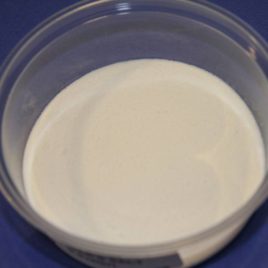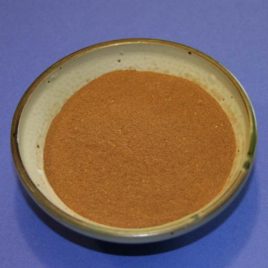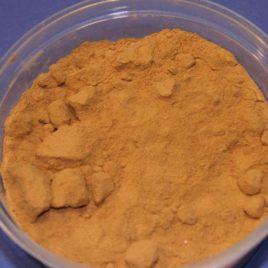Back to Mordants and Additives
“Urea (Ammonium nitrate) – 250g” has been added to your cart. View cart
Myrobalan, Ground
$3.30 – $25.50
Ground nuts of a tropical tree, Terminalia chebula.
Use on protein or cellulose fibres. Considered both a mordant and a dye, because of the high tannin content. Yields a light butter-yellow to beige or mushroom. Substantive, no mordant needed. Use at 15-20% WOF as a mordant on cellulose fibres. As a dye, use at 20-30% WOF for medium shades.
TO USE:soak 24 hrs in water to dissolve. Add more water if necessary and enter fibre. Bring to a high simmer for 1 hour. Let fibre cool overnight.
Light and washfastness: good.
SKU: N/A
Categories: Mordants and Additives, Natural Dyes
Tags: beige, butter yellow, mushroom, natural dyes
Related products

Glauber’s salt
Sodium sulphate. Used as a LEVELLER in both synthetic and natural dyeing.
Glauber's salt slows down the colour uptake of the dye, encouraging more even and level strike. This is particularly useful when dyeing soft pastel shades.
TO USE: Calculate amount required for 10 to 50% WOF (weight of fibre), lower amounts for softer shades, higher amounts for deeper colours. Dissolve in hot water and add in stages during dyeing, as the bath temperature rises but before dye strikes.
Dispose of spent dyebath in your usual way. Down the drain is fine.
CAUTION: wear a mask when handling powders.

Pomegranate, Ground Rind
Powdered/ground rind from the rinds of pomegranate fruits, Punica granatum. NOTE: this is NOT EXTRACT. This is the kind to use if you want to try it as a natural mordant.
We list this as a natural dye, but it is sometimes used as a mordant.
Use on protein or cellulose fibres. Yields soft yellows to green-yellows or gold. Substantive but pre-mordanting recommended. Use at 15-20% WOF for medium shades.
TO USE: soak 24 hours in hot water, stirring occasionally, then strain. Place liquid and fibre in dyepot and add more water if necessary. Bring to a high simmer for 1 hour. Let fibre cool in dye liquor for at least one more hour or overnight then wash and rinse.
Light and washfastness: moderate to good.

Tannin Blend
This is a blend of NATURALLY-SOURCED Tannin, usually from Quebracho and Sumac, possibly others. It will leave your plant fibres or fabrics a soft red-brown base colour before using other dyes.
Used mainly on as a MORDANT on cellulose fibres such as cotton, usually in combination with Alum.
TO USE: weigh dry fibre. Calculate mordant required at 15 to 20%% WOF (weight of fibre) each of Tannic Acid and Alum. Weigh mordants and dissolve in hot water in separate plastic or non-reactive containers. Add wetted fibre to Alum solution and soak for 12 to 24 hours. Rinse and place in Tannic Acid solution for 12 to 24 hours. Rinse again and place back in Alum solution for 12 to 24 hours. Wash and rinse well, then dye or dry for later use.
Spent mordant solution may be safely disposed of down the drain (except for septic systems). It also may be poured around garden plants that prefer acidic soil conditions.
CAUTION: wear a mask when handling powders. Wear gloves when using tannins, particularly when rinsing or handling wet yarns as they can cause skin irritation and staining.

Indigo, Natural Ground
PLEASE NOTE: Indigo dyeing is an art and science that you need to research ahead of time. It is NOT handled like any of the other natural dyes, by simmering on the stove!!
Finely ground powder from Indigofera tinctoria.
Use on protein or cellulose fibres. A vat dye, Indigo must be handled in a special way in order for the complex chemical process to occur. It produces a gorgeous range of true blue shades, depending on how many dips are done and how much indigo is used in the vat. The indigo magic will not work with the standard methods used for other natural dyes.
TO USE: follow one of the many recipes for setting up an Indigo vat. The internet is a good search source. We stock some of the supplies needed, depending on the method. Thiourea dioxide and Soda Ash are the two most commonly used ingredients, which we stock. Lye is also used sometimes, and due to its caustic nature we will not stock it: any good hardware store sells lye in with the cleaning products. We highly recommend looking at the pdf tutorials on Indigo at www.maiwa.com
Light and washfastness: excellent.


